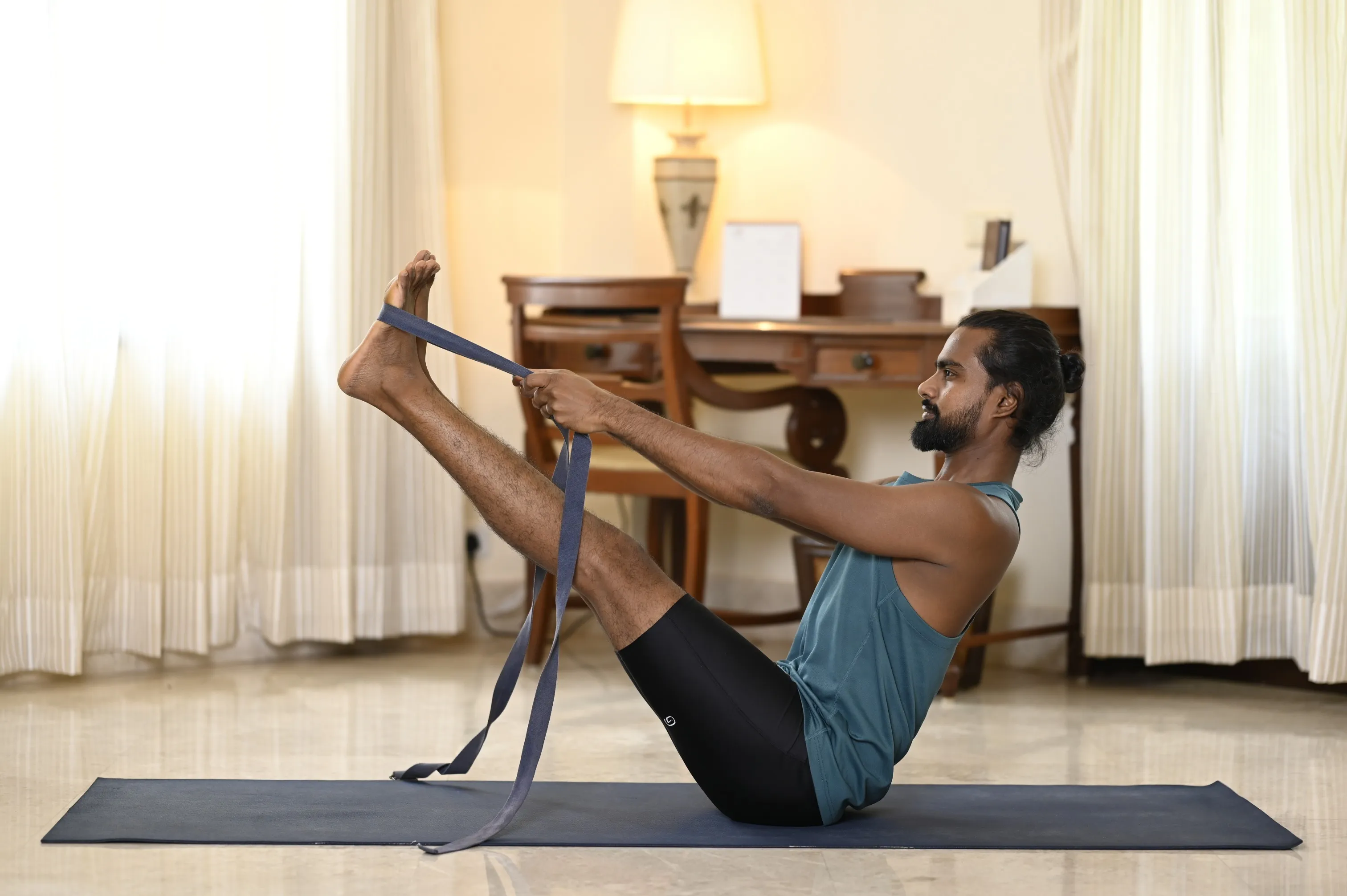What is Supta Padangusthasana (Reclining Hand to Big Toe Pose)?

Supta Padangusthasana, or the Reclining Hand to Big Toe Pose, is a beginner-to-intermediate level yoga posture suitable for unwinding the spine, neck, and low back. While the practitioner focuses on extending and opening the hamstrings, glutes, and calf muscles.
This pose is an incredible stretch for people having tight back and leg muscles. Start by extending one leg straight in the air, holding the big toe from the fingers lock, and stretching the leg close to the forehead to feel awareness entering your overall body.
Overview & Etymology
The name Supta Padangusthasana emerges from the combination of a few Sanskrit words, where—'Supta' means 'reclining,' Pada' means 'foot,' 'Angustha' means 'big toe,' and 'Asana' means 'posture.'
The Reclining Hand to Big Toe Pose is a modern-day yoga pose; therefore, there is no detailed reference about this posture practice in any ancient hatha yoga texts.
However, it became popular during the 20th century as it was a part of Ashtanga Vinyasa Yoga's primary series by K. Pattabhi Jois and K. Pattabhi Jois.
Sanskrit Name: सुप्त पादाङ्गुष्ठासन Pronunciation: SOOP-tah pahd-ahng-goosh-TAHS-uh-nuh
Pose Type: Restorative Reclining Stretch Also known as: Supine Hand to Toe Pose
Strengthens: Inner Thigs, Hip-Flexors, Glutes, Groin, Hamstrings, and Knees
Stretches: Inner Thigs, Calfs, Hip-Flexors, Glutes, Groin, and Hamstrings
Health Benefits of Supta Padangusthasana
Improves flexibility.
Soothes sciatic pain.
Aids in aligning the pelvis.
Enhances reproductive health.
Stretches the overall leg muscles.
Improves digestive system function.
Activates the root and sacral chakra.
Reduces mild symptoms of back pain.
Relieves mild arthritis and knee pain symptoms.
Lengths and strengthens the legs, arms, and shoulders muscles.
When to Avoid Performing Supta Padangusthasana
Avoid post-cesarean delivery.
Avoid during shoulder or knee joint injury.
Avoid if lying down on the back is painful.
Avoid during hamstrings, quads, or glutes muscle injury.
How to do Supta Padangusthasana (Reclining Hand to Big Toe Pose)
To perform the Supta Padangusthasana, we have divided the practice into four easy-to-follow different segments. These include warm-ups, main posture steps, alignment cues, and relaxing asanas.
Let's take a closer look at each segment:
Part 1 - Preparatory Poses for Supta Padangusthasana
Prepare for Supta Padangusthasana by warming up your glutes, pelvis, hamstrings, and back. Follow the below-listed preparation sequence:
1. Apanasana Variation (Knees to Chest Pose with Single Leg) - Lie on the yoga mat over your back, bend one leg and bring the knee close to your chest.
Wrap your arms around the knee, hug the arms tight and lock your forearms by gripping the opposite elbows.

This is an ideal pose to gently activate blood circulation in your inner thighs, pelvis, and lower back. Hold this pose on each side for 2 to 3 minutes.
2. Sucirandhrasana (Eye of the Needle Pose) - Stay lying on your back and start to simply—lift and bend the legs up in the air. Take your right leg and cross it over the other while resting your right leg's ankle just below the left leg's knee.
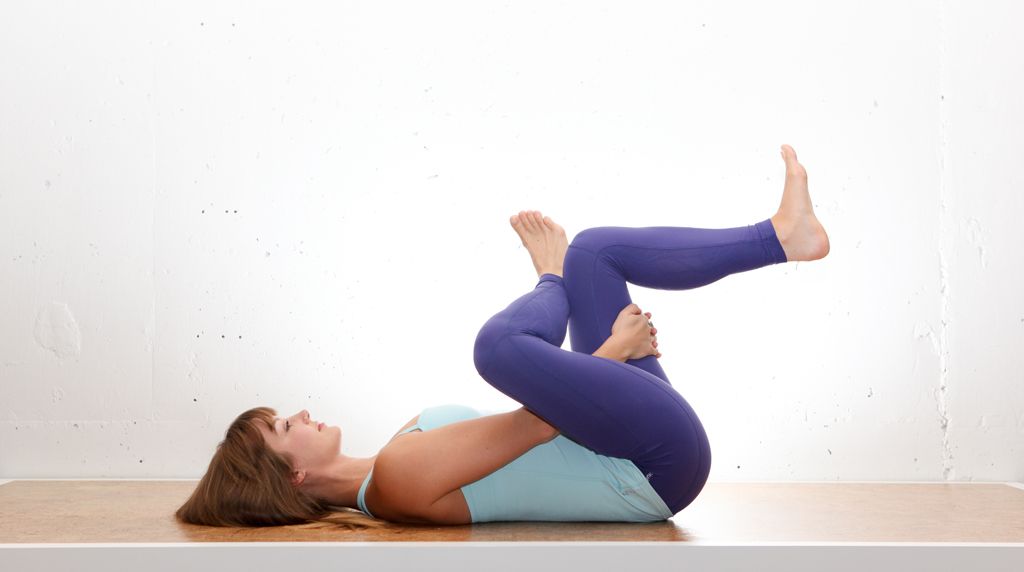
Grip the left thigh muscles with your palms and interlock your fingers as you start to pull the leg very gently closer to your chest. While you pull the leg closer, consciously feel your glutes muscle stretching deeply.
Hold this on each side for a couple of minutes until you feel your glutes opening up.
Part 2: Step-by-Step Instructions to Perform Supta Padangusthasana
The following are steps to practice the reclining hand to big toe pose:
Step 1- Take a deep breath in, exhale and lie down on your back. Engage your core muscles here so that the navel is trying to reach the tailbone.
Step 2- Lift the right leg avoiding any bending or turning out of the leg. Simply, keep the lifted leg straight and your toes pointed.
Step 3- Place the left arm on the left side in straight resting mode. Next, take your right arm, extend the arm overhead and reach the toes of your right foot.
Step 4- Inhale, flex your leg straight, stabilize the pelvis, and maintain the left leg flat on the ground.
Step 5- Hold the pose here for 10 to 30 seconds on each side, and repeat the same on the other side.
Breath Awareness:
Inhale - While engaging the core and leg muscles.
Exhale - When ready to release the pose.
Inhale & Exhale - Before getting into the pose and while holding the stretch for a long duration.
Performance Duration for Beginners: Hold the reclining hand to the big toe pose for 30 to 90 seconds on each side.
Performance Duration for Advanced: Hold the reclining hand to the big toe pose for 2 to 5 minutes on each side.
Part 3: Things to Keep in Mind
Prior to getting into Supta Padangusthasana, keep these posture cues in mind:
Engage your legs and core muscles - You won’t be able to feel any stretch in the back of your legs or glutes if you’re not engaging the quad muscle and straightening the leg completely.
Also, if the core is not engaged properly, you won’t be able to lift and hold the leg up in the air for a longer duration.
Stabilize the lower leg - If your left leg starts to rise up as you stretch the right leg up in the reclining hand to the big toe pose, then stabilize it with your left arm.
Place the left arm over your right front thigh and ensure your left leg is not rising off the mat.
Part 4: Relaxing Poses After Supta Padangusthasana
Perform the following relaxing asanas to release any tension in your legs, pelvis, or lower back:
1. Supta Baddha Konasana (Reclining Bound Angle Pose) - Begin by lying on your back and stepping your heels towards your pelvis. Inhale, and open your knees to the bottom of the feet touch in Namaste formation.
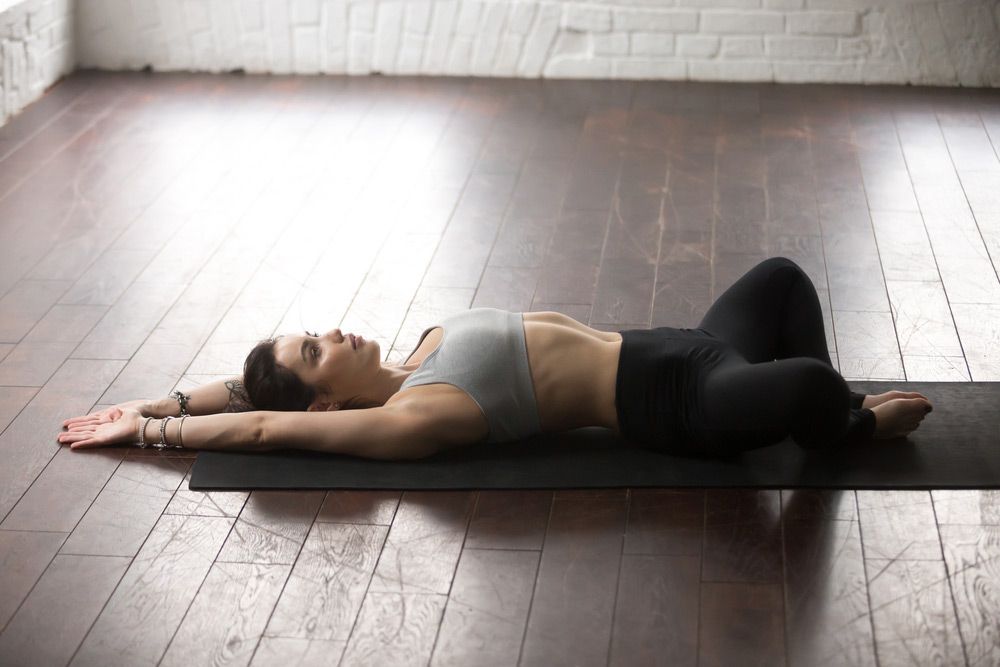
Exhale and bring the knees closer to the ground. If this is too intense, put a bolster below your spine and yoga blocks under each knee. This pose is excellent for gently relaxing your spine, pelvis, and lower body.
2. Shavasana (Corpse Pose) - This pose will help you restore the whole body. Continue the Reclining Bound Angle Pose and spread your legs straight on the mat with your palms facing the ceiling on the side.

Close your eyes and mindfully focus on your breath. With each breath, you take, relax the whole body consciously and maintain this pose for as long as you feel comfortable.
Supta Padangusthasana Variations to Consider
If you want to tweak your Supta Padangusthasana practice, try these posture variations:
1. Supta Padangusthasana Extention With Bent Leg: If you are constantly facing issues with your in-active leg rising, then we have a solution for you.
Simply, bend the inactive leg and place the foot close to your pelvis. This will help you stabilize and stop the other leg from rising unnecessarily.
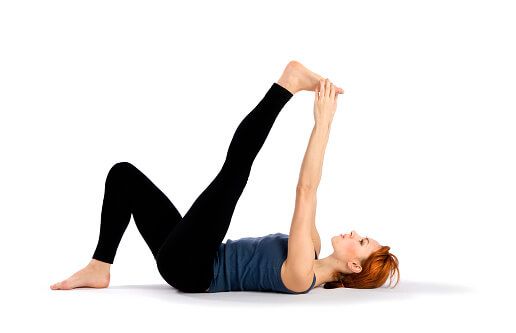
Also, this pose minimizes the intensity of the stretch in the legs, making it a perfect variation for beginners.
2. Supta Padangusthasana Holding the Hamstring: Continue to challenge your lower body further by straightening the inactive leg and resting it on the ground.
But, instead of holding the toes with your palms, grip your active leg’s thighs. This posture variation is excellent for beginners who find it initially challenging to hold their feet with their palms.

Hold this variation on each side for 2 to 3 minutes and as you feel more flexible, scooch your hands upwards closer to the foot.
3. Supta Padangusthasana on the Side: Once you feel strong enough at performing the Supta Padangusthasana with straight legs in the air, next try this advanced variation.
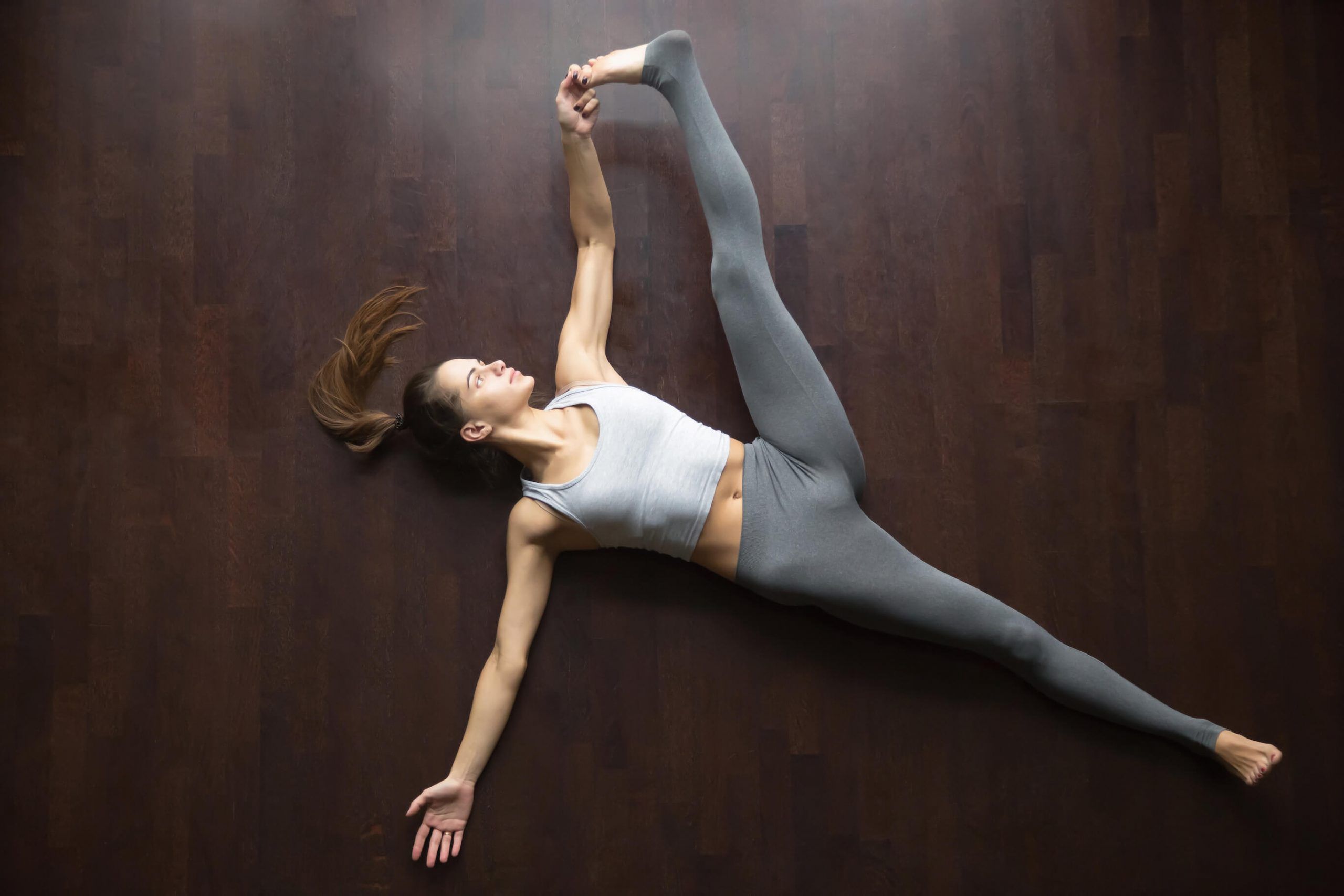
Take 4 to 5 deep breaths in straight leg Supta Padangusthasana pose, exhale, and externally rotate the active legs glute out to the side.
Rest the active leg on the side while stabilizing the other leg and core deep into the mat.

Enjoy a Free 1-on-1 Session with a Coach!
Receive personalized guidance tailored to your unique fitness goals, live with a dedicated coach—no credit card required.
Frequently Asked Questions about Supta Padangusthasana
Supta Padangusthasana is good for enhancing lower body flexibility, opening glutes for deep hip-opening poses, and enhancing blood circulation in the legs.
Supta Padangusthasana is a beginner to intermediate-level yoga pose. Thus, yes beginner can efficiently perform this pose, but make sure to warm up the lower body before getting started with the main posture.
Knees to Chest pose with single leg variation, Baby Cradle pose, and Eye of the Needle pose are different preparatory poses used to extend the tight glutes and activate your lower body for the Supta Padangusthasana practice.
Following are some vital health benefits of the Supta Padangusthasana:
- Stretches the spine.
- Boosts abdominal organ health.
- Increases overall blood circulation.
- Relive mild lower back pain symptoms.
- Increases lower body flexibility and strength.
To ease your main practice, try variations like Supta Padangusthasana extension with a bent leg or Supta Padangusthasana gripping the hamstring.
Whereas, if you feel even stronger, try the advanced variation of Supta Padangusthasana, i.e. stretching your leg on the side.
Supta Hasta Padangusthasana is another name for the pose Supta Padangusthasana. So, both of these are referred to as—Reclining Hand to Big Toe Pose in English.



%20(7).jpg)

